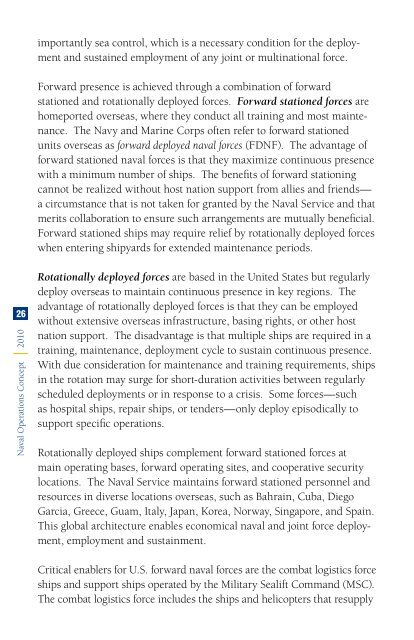Naval Operations Concept - Defense Technical Information Center
Naval Operations Concept - Defense Technical Information Center
Naval Operations Concept - Defense Technical Information Center
You also want an ePaper? Increase the reach of your titles
YUMPU automatically turns print PDFs into web optimized ePapers that Google loves.
<strong>Naval</strong> <strong>Operations</strong> <strong>Concept</strong> 2010 6<br />
importantly sea control, which is a necessary condition for the deployment<br />
and sustained employment of any joint or multinational force.<br />
Forward presence is achieved through a combination of forward<br />
stationed and rotationally deployed forces. Forward stationed forces are<br />
homeported overseas, where they conduct all training and most maintenance.<br />
The Navy and Marine Corps often refer to forward stationed<br />
units overseas as forward deployed naval forces (FDNF). The advantage of<br />
forward stationed naval forces is that they maximize continuous presence<br />
with a minimum number of ships. The benefits of forward stationing<br />
cannot be realized without host nation support from allies and friends—<br />
a circumstance that is not taken for granted by the <strong>Naval</strong> Service and that<br />
merits collaboration to ensure such arrangements are mutually beneficial.<br />
Forward stationed ships may require relief by rotationally deployed forces<br />
when entering shipyards for extended maintenance periods.<br />
Rotationally deployed forces are based in the United States but regularly<br />
deploy overseas to maintain continuous presence in key regions. The<br />
advantage of rotationally deployed forces is that they can be employed<br />
without extensive overseas infrastructure, basing rights, or other host<br />
nation support. The disadvantage is that multiple ships are required in a<br />
training, maintenance, deployment cycle to sustain continuous presence.<br />
With due consideration for maintenance and training requirements, ships<br />
in the rotation may surge for short-duration activities between regularly<br />
scheduled deployments or in response to a crisis. Some forces—such<br />
as hospital ships, repair ships, or tenders—only deploy episodically to<br />
support specific operations.<br />
Rotationally deployed ships complement forward stationed forces at<br />
main operating bases, forward operating sites, and cooperative security<br />
locations. The <strong>Naval</strong> Service maintains forward stationed personnel and<br />
resources in diverse locations overseas, such as Bahrain, Cuba, Diego<br />
Garcia, Greece, Guam, Italy, Japan, Korea, Norway, Singapore, and Spain.<br />
This global architecture enables economical naval and joint force deployment,<br />
employment and sustainment.<br />
Critical enablers for U.S. forward naval forces are the combat logistics force<br />
ships and support ships operated by the Military Sealift Command (MSC).<br />
The combat logistics force includes the ships and helicopters that resupply

















